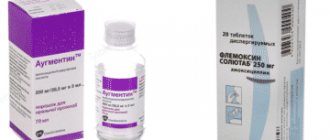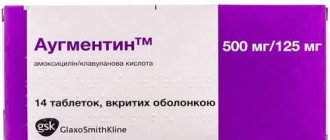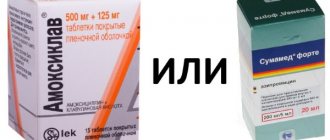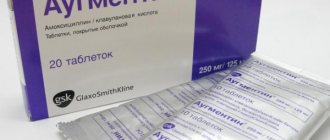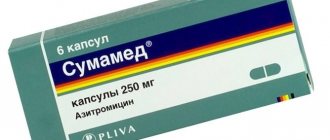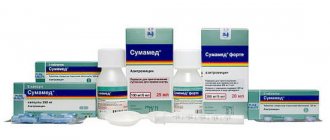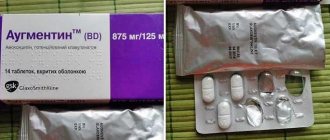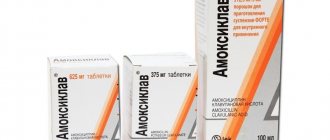When purchasing medications, any person wants to choose an effective and inexpensive one. One of the common options is Sumamed or Augmentin. At first glance, the effect of these drugs is the same, since both of them are broad-spectrum antibiotics. But there are many differences between them that need to be known before use.
Sumamed or Augmentin are broad-spectrum antibiotics.
Characteristics of Sumamed
This antibiotic has a wide spectrum of effects, a group of macrolides. Available in the form of tablets, capsules, powder for suspensions is more convenient for children. The active ingredient of Sumamed is azithromycin dihydrate. It penetrates the body of bacteria, stops protein synthesis, which leads to a stop in the development and reproduction of microorganisms.
The drug affects many bacteria.
Most often, Sumamed is prescribed for infections caused by microorganisms. Treatment with this drug is indicated for:
- infections of the ear, nose and throat;
- acute bronchitis;
- pneumonia caused by atypical pathogens;
- skin infections, for example, dermatosis, erysipelas, early stage Lyme disease;
- urinary tract infections caused by chlamydia.
Sumamed has many contraindications. As the drug is cleared from the liver, the load is placed on the liver. Therefore, if you have any problems or liver diseases, you should not take it.
Other contraindications include:
- individual intolerance to the main components;
- deficiency of sucrose enzymes;
- problems with the breakdown of carbohydrates due to the presence of starch in the composition.
Sumamed is used for pneumonia caused by atypical pathogens.
Names of tablets that can be taken for bronchitis
Many patients are interested in the names of antibiotics for bronchitis in adults in tablets. Some try, based on the experience of others, to choose their own treatment. But still, in order to avoid serious consequences, it is better to leave this prerogative to specialized specialists.
Azithromycin
For bronchitis in adults, Azithromycin is often prescribed. The drug contains an active substance with the same name, which belongs to the macrolides from the azalide group. The spectrum of its action is quite wide. It is produced by various Russian pharmacological companies.
Sumamed
Another popular antibiotic for bronchitis is Sumamed. This is a bacteriostatic antibacterial agent containing azithromycin. It is produced in Croatia. This is a more expensive analogue of domestic Azithromycin. The course dose of the drug is 1.5 g. Take it 1 hour before or 2 hours after a meal.
Augmentin
For bronchitis, Augmentin can be prescribed. The drug contains amoxicillin and clavulanic acid. The presence of the latter protects amoxicillin from destruction by beta-lactamases. Thanks to this, the spectrum of action of Augmentin significantly expands. The antibiotic is produced in the UK.
Solutab Flemoxin
The Netherlands produces the drug Flemoxin Solutab, used for bronchitis. It contains amoxicillin (semi-synthetic penicillin). The tablet is swallowed whole, chewed or pre-dissolved in water to form a syrup/suspension.
Suprax
Suprax is also used for bronchitis. It contains cefixime, a semi-synthetic antibiotic from the group of third-generation cephalosporins, which has a bactericidal effect. The tablet is swallowed with a glass of clean water, or a suspension is prepared from it and immediately drunk. The drug is produced in Italy.
Biseptol
For bronchitis in adults, Biseptol is often prescribed. This is a combination antimicrobial drug consisting of sulfamethoxazole and trimethoprim. It immediately fights a large list of microbial agents. Take Biseptol orally after meals. The dose is prescribed individually. Biseptol is produced in Poland.
Zinnat
The antibiotic Zinnat is also popular for bronchitis. It contains cefuroxime, an antibacterial agent from the group of second generation cephalosporins with a bactericidal effect. For optimal absorption, it is recommended to take the drug after meals. Zinnat is produced in the UK.
Doxycycline
For bronchitis, Doxycycline may be prescribed. The drug contains the active substance of the same name, which is a semi-synthetic tetracycline. It is a bacteriostatic antibiotic that acts against a variety of pathogens. Doxycycline is produced by domestic manufacturers and is available in capsules.
Ciprofloxacin
For bronchitis in adults, it is also appropriate to prescribe Ciprofloxacin. It contains the active component of the same name. It is produced by Russian and some foreign pharmaceutical companies. This is a broad-spectrum antimicrobial agent of the fluoroquinolone group.
When used on an empty stomach, the absorption of ciprofloxacin increases.
Action of Augmentin
Augmentin is an antibiotic of the penicillin group. The main component is amoxicillin trihydrate. This substance has undergone chemical modification, which has enhanced the properties of the drug. It penetrates bacteria and destroys their cells. The product is effective for various diseases caused by bacteria. The second main component is the potassium salt of clavulanic acid. It suppresses bacterial activity by blocking beta-lactamase (a kind of protection against antibiotics that the drug “affects”).
Augmentin is available in two forms: tablets and powder.
The product helps with bacterial infections that are caused by microorganisms sensitive to the drug. Most often, Augmentin is prescribed for:
- otitis, tonsillitis, inflammation of the nasal sinuses;
- pneumonia, bronchitis;
- cystitis, gonorrhea;
- bacterial lesions of the skin and soft tissues.
Used as complex therapy for mixed infections.
It has quite a lot of contraindications:
- severe liver and kidney disorders;
- high sensitivity to the main components of the drug;
- You can only take suspensions up to 12 years of age (at any age, if your weight is less than 40 kg);
- children under 3 months of age (taking the drug in any form is contraindicated).
Augmentin has rapid elimination (the process of removal from the body), so it is recommended to take it 3 times a day.
What antibiotics can be taken to treat sinusitis at home - list of drugs
Pharmacies offer a wide range of antibacterial drugs. They are available in the form of capsules, tablets, nasal spray and powder for suspension. In topical products, the active substance is contained in a smaller dosage; effectiveness is achieved through direct contact with the infected area. The choice of a specific antibiotic depends on age, weight and the course of sinusitis.
Azithromycin
Cheap antibiotic of domestic production. Azithromycin belongs to the first generation of macrolides and is effective at high concentrations of pathogenic microorganisms in the body. Shows effectiveness against a number of gram-positive bacteria. Available in the form of powder for suspensions, tablets and capsules. Can be used by children over 3 years old. Side effects from taking are reversible and rare. The cost starts from 86 rubles.
Azithromycin-based drugs can be replaced with tablets containing erythromycin. These antibiotics have similar properties and pharmacology.
Amoxiclav
A popular remedy included in the WHO list of essential drugs. Effectiveness is achieved through a combination of amoxicillin (a semi-synthetic analogue of penicillin) and clavulanic acid. The substances complement each other, resulting in rapid destruction of bacteria. It has a wide spectrum of action and is used for sinusitis of any severity. With long-term use, it is recommended to monitor the functioning of the hematopoietic organs and kidneys. Available in various forms, suitable for children and pregnancy. Cost from 170 rubles.
Recommended doses of Amoxiclav suspensions depending on body weight and severity of infection
Augmentin
Direct analogue of Amoxiclav, but produced in the UK. It has the same properties, pharmacological effects and contraindications. Available in the form of tablets and suspensions in dosages from 156 ml to 1 g. The average price is 300 rubles.
Biseptol
Polish remedy in the form of tablets, suspensions in dosages of 120, 240 and 480 mg. A complex antibacterial drug containing sulfamethoxazole and trimethoprim. Their combination is used to treat infectious forms of sinusitis of moderate and severe severity. The duration of the therapeutic effect is 7 hours, the components are completely eliminated from the body. Biseptol is contraindicated in pregnancy, sensitivity to sulfonamides, renal failure and blood diseases. The course of treatment should not exceed 10 days. Cost from 37 rubles.
The combination of sulfamethoxazole and trimethoprim has not only powerful antibacterial, but also pharmacological activity. When using complex treatment, you should carefully read the instructions to avoid reactions with other drugs.
Vilprafen
Tablets based on josamycin. This is a broad-spectrum antibiotic, belongs to the group of macrolides. Affects the protein synthesis of bacteria, as a result of which their growth is disrupted and reproduction is inhibited. The advantages of the product are a low risk of complications from the digestive system, effectiveness against bacteria resistant to erythromycin. Vilprafen is suitable for long-term treatment; pathogens rarely develop resistance. During therapy, you should absolutely not skip a dose - this reduces the pharmacological properties of the medicine. Suitable for children, during pregnancy and lactation. The price starts from 540 rubles.
Suprax
Available in the form of tablets in a dosage of 500 ml, suspensions - 5 ml. The active substance, cefixime, belongs to the latest generation cephalosporins. Inhibits the synthesis of the cell membrane of the pathogen, suitable for the treatment of sinusitis caused by gram-positive and gram-negative bacteria. Not recommended for children under 12 years of age with hypersensitivity to penicillin. The duration of the course should not exceed 10 days; for chronic kidney diseases, it is advisable to reduce the daily dose by 25%. The average price is 700 rubles.
Suprax is available in the form of water-soluble granules and capsules.
Flemoxin Solutab
Popular tablets and suspension based on amoxicillin. The drug is prescribed as the main drug for the treatment of bacterial sinusitis, and also as an analogue of Augmentin. May cause adverse reactions from the digestive and excretory systems. It is necessary to strictly follow the treatment regimen and prescribed dosage. Can be used during late pregnancy. With long-term combined antibacterial treatment, cross-resistance with penicillin drugs may occur. Cost – 250 rubles.
When treated during lactation, amoxicillin begins to be excreted in milk. Breastfeeding should be stopped as it threatens the health and development of the child.
Ceftriaxone
This is a 3rd generation cephalosporin antibiotic. It has a wide spectrum of action and inhibits the synthesis of cell walls of microorganisms. Active against most pathogens of sinusitis. Available in powder form for intravenous or intramuscular administration. Well tolerated by the body, the maximum effect occurs after 2-3 hours. Suitable for the treatment of sinusitis in newborns, the elderly and people with weakened immune systems. If it is necessary to take it during lactation, breastfeeding should be discontinued. Price from 40 rubles.
What is the difference and similarity between Sumamed and Augmentin?
Among the main differences are:
- Active ingredient. Sumamed has azithromycin (from the group of macrolides), Augmentin has amoxicillin of the penicillin series. They act differently on bacteria and viruses, although they have a similar purpose.
- Application. Sumamed is excreted over long periods after administration and accumulates, so it is taken once a day. Augmentin is taken 2-3 times a day, depending on the diagnosis.
- Duration of treatment. Therapy with Sumamed lasts 3-5 days, Augmentin - at least 7 days.
- Adverse reactions. Like all penicillin antibiotics, Augmentin can cause allergies in the form of skin rashes. And taking Sumamed often leads to digestive disorders.
- Replacing the drug. The ineffectiveness rate of Augmentin is about 20%, which necessitates a change in medication. When taking Sumamed, this figure is lower - only 5%.
What is better and in what case – Augmentin or Sumamed
What is the difference between Augmentin and Sumamed? Which of the drugs is better and more effective, in which cases - is discussed below.
Is this the same drug, or two different ones?
Augmentin and Sumamed are various antibacterial agents that are quite often prescribed for similar diseases. Also, the effectiveness of both drugs has been confirmed not only experimentally, but also by long-term clinical use of these antibiotics.
Augmentin is a combined antimicrobial drug that consists of the synthetic penicillin antibiotic amoxicillin and the specific beta-lactamase inhibitor clavulanic acid.
The drug is characterized by a bactericidal effect - its particles penetrate into the bacterial cell and disrupt the integrity of the cytoplasmic membranes of microbes. This causes their rapid death.
Clavulanic acid blocks the action of enzymes that bacteria produce in order to break down drug molecules.
Additionally, it also has an antimicrobial effect, which expands the spectrum of action of the product.
Sumamed is a medicine consisting of azithromycin, which is classified as a bacteriostatic agent from the group of macrolides.
It is characterized by an effective action against most pathogens of bacterial pathologies of the respiratory organs. The mechanism of action of the drug is different - it blocks the functioning of ribosomes, which leads to the inability to divide the bacterial cell.
Which drug, Sumamed or Augmentin, is safer?
It is difficult to answer which is better, Augmentin or Sumamed in terms of side effects. Both penicillins and macrolides are groups of antibacterial agents with good proven safety in clinical practice. They have been used for many decades, and during this time no drugs have been invented with a lower frequency of side effects.
The safety profile of both drugs has been confirmed in various categories of patients. Both Sumamed and Augmentin are allowed to be used during pregnancy, lactation and from the first year of a child’s life, if indicated.
Sumamed and Augmentin differ in the most common side effects that develop during their use. So for Augmentin, as for all penicillin medications, various allergic reactions are most typical.
Approximately 10% of the general population has hypersensitivity to beta-lactam antibiotics, so testing for this condition should be done before first use.
When taking Sumamed, complications from the cardiovascular system are most often observed (the development of tachyarrhythmias in the presence of congenital malformations of the conduction system), a transient increase in hepatic cytolysis enzymes and bilirubin, fulminant toxic hepatitis, the development of secondary infectious diseases and dysfunction of the digestive organs.
Are Sumamed and Augmentin interchangeable antibacterial agents?
Although quite often Sumamed and Augmentin are prescribed for the same diseases, there are quite large differences in the range of indications for these medications. This is primarily due to the peculiarities of pharmacodynamics and metabolism of antibiotics.
Augmentin is well absorbed when administered orally. The drug practically does not undergo metabolism in the body and accumulates evenly in various tissues and systems of the body.
In this case, the elimination of the antibiotic occurs almost completely through the genitourinary system. Therefore, it is used not only for bacterial diseases of the respiratory tract, but also of the kidneys, urinary tract, prostate, and musculoskeletal system.
Sumamed has a pronounced affinity for the respiratory epithelium. After administration, its concentration in the mucous membrane of the respiratory tract can exceed several tens of times its content in the patient’s blood plasma. Part of the drug dose undergoes inactivation processes into various metabolites in the liver, and the other part is excreted in the urine.
Because of this, Sumamed is mainly prescribed for bacterial diseases of the throat, bronchi and lungs, as well as for chlamydia infection.
Which drug is more effective for bronchitis or pneumonia?
In modern recommendations for the treatment of bacterial pneumonia or bronchitis, Sumamed and Augmentin are considered almost equivalent drugs. Any of them can be prescribed for an uncomplicated form of the disease in patients without serious concomitant pathologies.
Research on the effectiveness of various antibacterial drugs is regularly conducted around the world.
They have become especially relevant recently against the backdrop of information about the increasing resistance of pathogenic flora to the most commonly used antibacterial agents.
This was also facilitated by the frequent irrational use of antibiotics, especially the prescription of reserve drugs for mild forms of pathologies and uncontrolled use for viral diseases.
Recent data convincingly indicate an increase in the resistance of microflora to penicillin medications, in particular Augmentin.
Now in more than 20% of cases of therapy with this drug it is necessary to replace it with another antibacterial agent due to insufficient effectiveness.
A more favorable situation with Sumamed.
Despite the fact that this drug has been actively used in clinical practice since the 1980s, the cumulative antibiotic resistance among sensitive flora does not yet exceed 5%.
Another factor that speaks in favor of Sumamed is the possibility of combining it with third-generation cephalosporins, which significantly enhances the antibacterial potential.
Which of these antibiotics is more convenient for practical use?
Here the answer is obvious - Sumamed. To carry out a course of treatment for most bacterial pathologies of the respiratory tract (with the exception of pneumonia), only three tablets are sufficient.
In this case, only one dose per day is necessary, regardless of food.
After the last use of the medication, a sufficient amount of it remains in the tissues for another 3 days, which allows the patient to be completely cured.
Augmentin has a faster elimination from the patient's body. Therefore, it must be taken for at least 5 days every 12 hours. In some situations, this medication is recommended to be used 3 times a day.
However, the decision about which drug to prescribe in a particular situation, Augmentin or Sumamed, is made only by a qualified attending physician.
The video talks about how to quickly cure a cold, flu or acute respiratory viral infection. Opinion of an experienced doctor.
Source: https://med-antibiotiks.com/voprosy/chto-luchshe-iv-kakom-sluchae-augmentin-ili-sumamed/
What is better to take: Sumamed or Augmentin?
Only a doctor can accurately prescribe a drug, taking into account the patient’s condition, the presence of contraindications, and possible side effects.
It also depends on the following factors:
- Range of action. The effects of the drugs are similar, but they do not completely overlap. Thus, Augmentin is effective against diseases caused by viruses and certain groups of bacteria. Sumamed does not act on viral infections, but it is able to cope with almost any group of bacteria.
- Interaction with other medications. They also interact with other medications in different ways. Therefore, Sumamed is more effective when used in complex therapy, since it allows simultaneous use with other antibiotics.
- For a child. Children, especially preschoolers, have difficulty taking medications. In this regard, Sumamed is more convenient - you need to drink it once a day for 3 days.
Augmentin is effective against diseases caused by viruses and certain groups of bacteria.
Comparison of Augmentin and Sumamed
The presence of similarities between pharmaceutical drugs does not indicate that the drugs are equivalent to each other.
Similarities
Both drugs are broad-spectrum antibiotics. The drugs have similar indications for use. Medicines are undesirable for use during pregnancy and breastfeeding. Both medications can cause diarrhea and thrush.
What is the difference?
The use of Augmentin leads to the lysis of cells of pathogenic microflora, and Sumamed inhibits the growth and reproduction of bacteria. The spectrum of action of Augmentin is wider. Sumamed has a more specific effect.
The severity of allergic reactions when using Augmentin is higher than when using Sumamed. Sumamed differs in that it has more contraindications.
Augmentin can be used from 3 months of age, and Sumamed only from 6 months.
Which is cheaper?
Augmentin has a lower cost compared to Sumamed. Tablets of this product can be purchased at prices ranging from 158 to 648 rubles. Sumamed is sold at prices ranging from 434 to 1010 rubles.
Conditions for dispensing from pharmacies
Both medications are available in pharmacies only with a doctor's prescription.
Is it possible to replace Sumamed with Augmentin?
These drugs can be interchangeable in the following cases:
- When treated with one of them for more than 7-10 days, the patient did not recover or at least clinically noticeable improvement. Ineffective treatment occurs when bacteria become resistant to the action of the antibiotic.
- If unpleasant allergic reactions to the drug occur. Due to the fact that they belong to different groups, the risk of cross-reaction is reduced to zero.
- With severe side effects. Since the drugs have different mechanisms of action, the chance of side effects that were observed with treatment with one of the medications being treated with another drug is negligible.
However, the final decision on replacement should rest with the doctor.
Doctors' opinion
Anna, 34 years old, plastic surgeon
I often prescribe Augmentin in the presence of inflammatory processes, after operations. The product has a pronounced antibacterial effect and quickly treats infections. The only negative is frequent problems with the gastrointestinal tract, so I recommend taking additional probiotics.
Irina, 38 years old, pediatrician
Augmentin is more often prescribed to children, especially if there are difficulties with taking pills - I recommend that young patients take a suspension, it dissolves easily, there are no grains in it that could cause a gag reflex in a child. The drug itself is relatively inexpensive, does not cause side effects, and shows its best side.
Alexander, 29 years old, dermatologist
Sumamed is a good proven antibiotic. It acts quickly, has a convenient form, and treatment is inexpensive. But since it is an antibiotic, it should be taken along with probiotics to avoid stomach problems.
